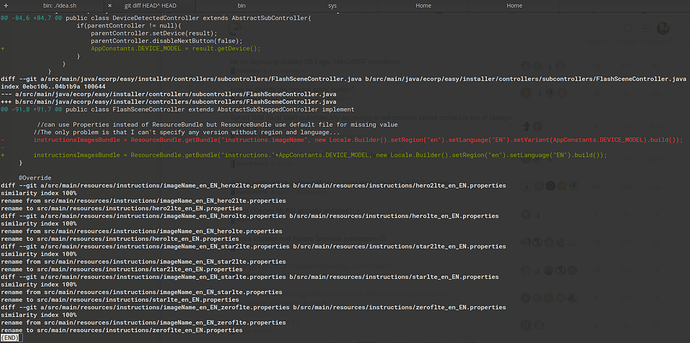Currently I’m stuck again where I want to test the packaged installer with added FP3 support.
I’ve run ./gradlew dist which creates build/distributions/easyInstaller-linux-x64.zip
When I unzip that archive and run easy-installer from the bin subdirectory, the installer comes up and I can proceed to the screen where my FP3 gets detected.
But then the ‘Continue’ button is greyed out and the console shows an error:
Exception in thread "JavaFX Application Thread" java.lang.IllegalAccessError: class org.yaml.snakeyaml.TypeDescription (in module Easy.installer.merged.module) cannot access class java.util.logging.Logger (in module java.logging) because module Easy.installer.merged.module does not read module java.logging
at Easy.installer.merged.module/org.yaml.snakeyaml.TypeDescription.<clinit>(Unknown Source)
at Easy.installer.merged.module/org.yaml.snakeyaml.constructor.Constructor.<init>(Unknown Source)
at Easy.installer.merged.module/org.yaml.snakeyaml.constructor.Constructor.<init>(Unknown Source)
at Easy.installer.merged.module/org.yaml.snakeyaml.Yaml.<init>(Unknown Source)
at ecorp.easy.installer/ecorp.easy.installer.threads.ThreadFactory.loadYAMLFile(Unknown Source)
at ecorp.easy.installer/ecorp.easy.installer.threads.ThreadFactory.changeMould(Unknown Source)
at ecorp.easy.installer/ecorp.easy.installer.controllers.MainWindowController.setDevice(Unknown Source)
at ecorp.easy.installer/ecorp.easy.installer.controllers.subcontrollers.DeviceDetectedController.lambda$startDetection$0(Unknown Source)
at javafx.base/com.sun.javafx.event.CompositeEventHandler$NormalEventHandlerRecord.handleBubblingEvent(Unknown Source)
at javafx.base/com.sun.javafx.event.CompositeEventHandler.dispatchBubblingEvent(Unknown Source)
at javafx.base/com.sun.javafx.event.EventHandlerManager.dispatchBubblingEvent(Unknown Source)
at javafx.base/com.sun.javafx.event.EventHandlerManager.dispatchBubblingEvent(Unknown Source)
at javafx.base/com.sun.javafx.event.BasicEventDispatcher.dispatchEvent(Unknown Source)
at javafx.base/com.sun.javafx.event.EventDispatchChainImpl.dispatchEvent(Unknown Source)
at javafx.base/com.sun.javafx.event.EventUtil.fireEventImpl(Unknown Source)
at javafx.base/com.sun.javafx.event.EventUtil.fireEvent(Unknown Source)
at javafx.base/javafx.event.Event.fireEvent(Unknown Source)
at javafx.graphics/javafx.concurrent.EventHelper.fireEvent(Unknown Source)
at javafx.graphics/javafx.concurrent.Task.fireEvent(Unknown Source)
at javafx.graphics/javafx.concurrent.Task.setState(Unknown Source)
at javafx.graphics/javafx.concurrent.Task$TaskCallable.lambda$call$1(Unknown Source)
at javafx.graphics/com.sun.javafx.application.PlatformImpl.lambda$runLater$10(Unknown Source)
at java.base/java.security.AccessController.doPrivileged(Native Method)
at javafx.graphics/com.sun.javafx.application.PlatformImpl.lambda$runLater$11(Unknown Source)
at javafx.graphics/com.sun.glass.ui.InvokeLaterDispatcher$Future.run(Unknown Source)
at javafx.graphics/com.sun.glass.ui.gtk.GtkApplication._runLoop(Native Method)
at javafx.graphics/com.sun.glass.ui.gtk.GtkApplication.lambda$runLoop$11(Unknown Source)
at java.base/java.lang.Thread.run(Unknown Source)
I’m not familiar with the Java module concept. It seems I need to grant access to module java.logging for module org.yaml.snakeyaml (or for the entire bundled application?).
But I don’t know how to do that. My naive though was to try something like
opens java.logging to org.yaml.snakeyaml;
in module-info.java, but that gives an error:
> Task :compileJava
/x01/user/ingo/FP3/eelo/easy-installer/src/main/java/module-info.java:32: warning: package is empty or does not exist: java.logging
opens java.logging to org.yaml.snakeyaml;
^
Any idea how to fix this?
Edit: Not sure if that is a good solution, but it works when I add mergedModule setting as below in build.gradle:
jlink {
imageZip = project.file("${buildDir}/distributions/${appPackaging}.zip")
options = ['--strip-debug', '--compress', '2', '--no-header-files', '--no-man-pages']
mergedModule {
requires "java.logging"
}
[...]
}
Unfortunately then the next error is when wiping the user data with fastboot -w:
/x01/user/ingo/FP3/eelo/linux-installer/bin/adb/mke2fs failed with status 1
fastboot: error: Cannot generate image for userdata
So I also need to package mke2fs.
 looks like we were too focused on the Samsung devices while writing the code.
looks like we were too focused on the Samsung devices while writing the code.
 I did not noticed it until i wanted to create custom instructions and pictures.
I did not noticed it until i wanted to create custom instructions and pictures.
